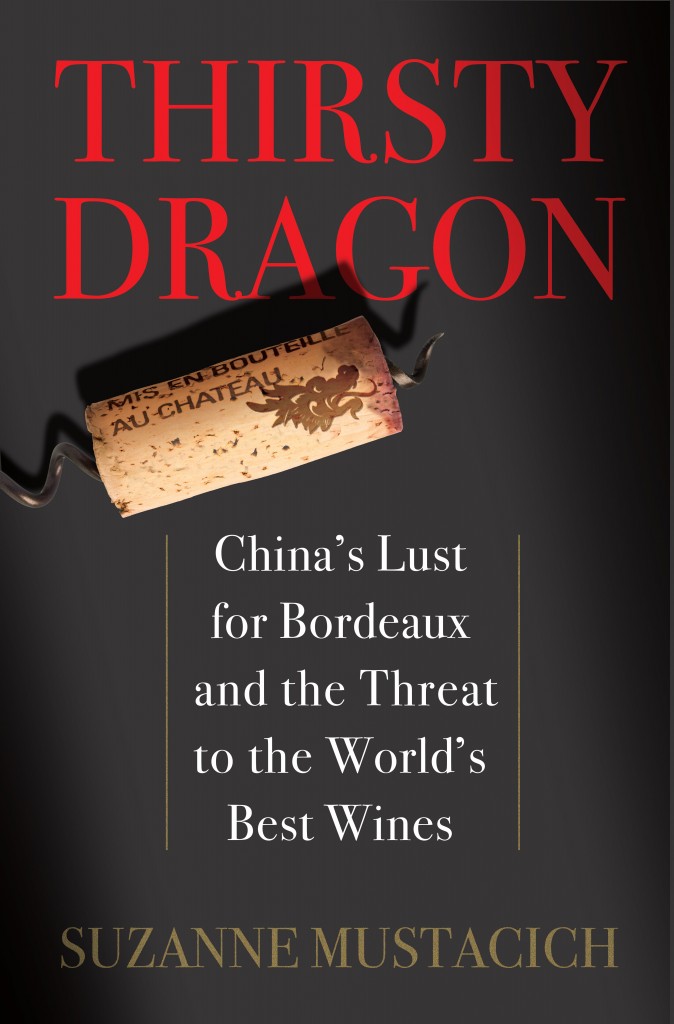New Book Details China's Big Thirst for Bordeaux Wine
In October of 2010, three bottles of 1869 Château Lafite were sold at auction in Hong Kong to a mysterious Chinese buyer for $230,000 each. The price set a record for the most expensive bottle ever sold and made headlines around the world. It also signaled just how fervent Chinese demand had become for prestigious First Growth Bordeaux. Given that a decade earlier hardly anyone in China knew what a corkscrew was, this was an astounding development. Just how China and Bordeaux forged this unlikely partnership is the subject of Suzanne Mustacich's new book Thirsty Dragon: China’s Lust for Bordeaux and the Threat to the World’s Best Wines. High drama is a rarity in the wine world, but Mustacich's account is an unexpected page-turner, made all the more vivid through the personal stories of many of the main players. We hear from a French négociant who confiscates millions of dollars of wine owned by a Chinese tycoon after he backs out of a deal (he's still fighting for his $8.5 million), and about the miniskirt brigade, a flock of young Chinese women who descend on Bordeaux eager to offer their translating services (nothing like tramping through a vineyard in a short skirt and stilettos!). We learn of Chinese investors buying up chateaux with the intention of shipping wine directly to China and thus eliminating all the middlemen. What then of the traditional en primeur system? Meanwhile in China, we discover the intricacies and hazards for westerners doing business in an ever-changing political environment. A misunderstanding by one Canadian adventurer lands him jail, while Bernard Magrez, no slouch in the business world, is completely out maneuvered, packs up and goes home to France. Fraud is rampant, and the only one who seems to care enough to do something about it is a lone British investigator named Nick Barton.
Threaded through all this high-stakes tension is a detailed, well-researched history of both the Bordeaux wine trade and China's development as a wine market. Mustacich is well suited to the task. She holds an enology diploma from the University of Bordeaux and worked for Agence France Presse, Wine Business International and the Chinese magazine Wine Life before becoming a contributing editor at Wine Spectator.
Mustacich's dispassionate, journalistic eye is very much on display. Although she has lived in Bordeaux for more than 15 years, Mustacich is unsparing in her account of how the Bordelais completely misjudged their newest, most important clients. They interpreted China's interest as falling in love with their wines, while the Chinese viewed Bordeaux wines as a money-making commodity. For one Chinese businessman: "His approach was simple: buy the resource, eliminate the courtiers, ignore the négociants, bypass the importers and ship the wine to China where he could sell it himself." Taking things one step further, in 2011 he bought a château with plans to take the estate's $20 wine and sell it in China for $230. A Chinese agent who helped arrange the deal explained: "The biggest difference is that, in China, we do not have so many laws and we will do anything for money. In Bordeaux, people take care of their land and they do anything for good business."
Saving their business is what the Bordelais had in mind when they turned to the Chinese market. Dealings on the Place de Bordeaux are always a high-stakes game, but in the spring of 2009 the Bordelais found themselves backed into a corner. Most of the world was suffering from the worst financial crisis since the 1930's depression. When the en primeur campaign opened, Bordeaux's usual customer base in the U.S. and Europe was nowhere to be found. China's economy, however, was booming, and, as luck would have it, import duties on wine entering Hong Kong had recently been eliminated. Within a year hundreds of new wine companies had set up shop in Hong Kong and imports increased 80%.
For both sides the opportunities seemed endless, but the bubble was about to burst. After two years of escalating en primeur prices, buyers became skittish. By the spring of 2012 resale prices of the previous vintages were falling. Not wanting to lose money, many of the Chinese who had place en primeur orders for the 2011 vintage began backing out of their agreements. Not only was this was unheard of on the Place de Bordeaux, but it also meant that négociants were stuck with the bill. Meanwhile in China, the country's new president Xi Jinping announced a crackdown on corruption. The sudden disappearance of the gift-giving market sent sales of classified growths plummeting.
The last few years have seen a normalization of the market, with sales dominated by mid-priced wines meant to be consumed rather than gifted. Wines from other countries, such as Australia and the U.S. are increasing, but the biggest development has been China's own domestic production. Three large producers still dominate the market (Changyu, Great Wall and Dynasty), but the last decade has seen the emergence of terroir-focused vineyards, producing excellent wine. Grace Vineyard of Shanxi province and Silver Heights in Ningxia's Helan Mountains are two of the more heartening stories, while plans for 1000 châteaux, each with a hotel and 5-star restaurant, less so.
The story of China and wine is still evolving, with new developments continuing to make headlines. They've made no secret about their goal to be a global player in the wine market and eventually the largest wine producer in the world. What does that mean for Bordeaux? Even Mustacich is uncertain of its future, only that business on the Place has always been a gamble and will continue to be a gamble. Meanwhile millions of dollars of classified growths sit in Chinese warehouses, at mercy to fickle nature of the game.

